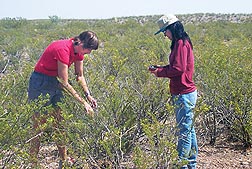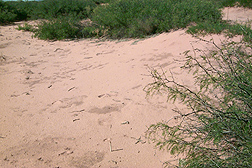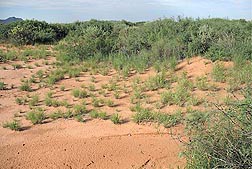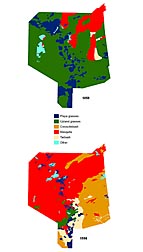Climate Change May Help Restore Arid Grasslands
|
|
Agricultural Research Service ecologist Debra Peters works in a daunting environment—an expanse of Chihuahuan desert in New Mexico that was once known as the “journey of the dead.” This is also where the U.S. Department of Agriculture established the Jornada Experimental Range, a 200,000-acre tract outside Las Cruces where scientists conduct research to help maintain sustainable livestock production and conserve natural resources on the surrounding arid land.
“We’re always looking for ways to relate grass production to precipitation, because this helps us extrapolate grass production to forage production,” says Peters. It’s a data-driven quest, and as a research facility celebrating its centennial in 2012, the Jornada is rich in data.
Peters was recently able to leverage some of that information to explore an intriguing hypothesis: In the future, warmer air temperatures from global climate change might generate more rainfall in the typically dry climate. If so, this could push the shrub-dominated desert rangeland over what Peters calls the “threshold of change” back into an ecosystem that supports growth and establishment of grasses.
Several years ago, Jornada researchers noticed grasses were starting to become established on land that had been vegetated with mesquite and creosote bushes. “We had some wet years that started in 2004 and continued through 2008,” Peters says. “There had been individual wet years before, but this was the first time there were five in a row. We thought the unusual grass production could be a response to the cumulative effect of the precipitation.”
|
|
Mapping the Changes
Small-scale grazing started on the Jornada in the 1600s, and maps compiled in 1858 by amateur cartographers on horseback indicated that more than 80 percent of the surveyed area was covered by grasslands. But by 1998, grasslands covered only about 15 percent of the same area. The same map collections showed mesquite coverage growing from 15 percent in 1858 to 59 percent in 1998, while tarbush and creosote shrubs had spread across some 20 percent of the previous grassland.
Peters and several other researchers at the Jornada station used these maps to compare changes in plant distribution with precipitation and to identify long-term trends in desertification. After the team pinpointed the changes in vegetation distribution over the past 150 years, they accessed data collected since 1989 by collaborators from the Jornada Basin Long Term Ecological Research project funded by the National Science Foundation. Data was available from five desert ecosystem types: upland grasses; playa grasslands; and mesquite, creosotebush, and tarbush shrublands. Then they compared the changes in herbaceous and woody species in average-rainfall years from 1989 to 1999 with changes after a sequence of dry years from 2000 to 2003 and after a series of wet years from 2004 to 2008.
|
|
The changes were identified by measuring biomass, above-ground net primary production (ANPP), plant diversity, and rain-use efficiency, which refers to grams of plant production per unit of precipitation. Ecologists use rain-use efficiency as a key indicator that signals ecosystem function change and potential grass recovery.
During the wet years, all study plots showed an increase in plant production, mainly by herbaceous plants. This increase was the highest on upland grasslands and mesquite shrublands, which were the sandiest sites.
When the scientists conducted additional comparisons, they found ANPP and plant diversity in three ecosystem types—upland grasses, mesquites, and tarbushes—were significantly higher in the wet period than the dry period. But it wasn’t just a linear relationship, since plant production in upland grasslands and mesquite shrubland during the wet period was greater than expected based on production measured during the dry period. Peters thinks that the wet years prompted a change in the interactions between grass plants and soil water, which in turn started a positive environmental feedback loop that supported additional growth and establishment of grasses.
Back to Grass
“Grass can germinate even during dry years, but it needs several years of moisture before it becomes established and puts out seed. And once grass is established, organic material collects at its base, so there’s an increase in biomass and litter on the soil surface,” Peters says. “When it rains hard on the Jornada, the water runs across the soil surface as sheet flow, but the accumulating biomass dams the flow. All of this makes conditions even better for grass growth, because there’s an increase in the level of soil moisture and the organic matter that supports plant growth, which allows survival even when conditions become dry again. In addition, the established grass survives long enough to put out seed to continue the cycle.”
Peters believes that if future climate results in more regional wet-year intervals, this could support the conversion of desertified shrub lands to savannas that support a mix of shrubs and grasses—and maybe the return to an ecosystem dominated by grasses. This back-and-forth dominance between grasses and shrubs has occurred several times in the Southwest over the past 10,000 years.
“Land managers have tried a number of things over the last 80 years to reestablish grass, but very little has worked,” Peters says. But she thinks that with sufficient increased precipitation over a sequence of years—and carefully managed grazing—the spread of productive grasslands could keep desert woody plants in check.—By Ann Perry, Agricultural Research Service Information Staff.
This research is part of Pasture, Forage, and Rangeland Systems, an ARS national program (#215) described at www.nps.ars.usda.gov.
Debra Peters is with the USDA-ARS Jornada Experimental Range and the Jornada Basin Long Term Ecological Research Program, 2995 Knox St., Las Cruces, NM 88003; (575) 646-4842.
ARS ecologist Debra Peters headed up the development of the EcoTrends Project, a multiagency effort to collect and synthesize long-term data for examining trends in Earth’s ecosystems.
“It started in 2006 as a result of a National Science Foundation meeting where we tried to compare trends in long-term data across different systems, but the data wasn’t in a format we could work with,” Peters says. “So we wanted to create something easier to use.” Peters and her colleagues created more than 60 standard data sets derived from detailed meteorological and biotic measurements that had been taken at 50 different sites. Much of the work involved converting data from individual locations into a format that was consistent and accurate across all locations—a task that took 4 years. The data will be available in a book to be published by the U.S. Department of Agriculture and at www.ecotrends.info. Peters and her colleagues hope that EcoTrends will encourage scientists, students, teachers, and decisionmakers to use long-term data to learn more about shifts in global climate change and how those shifts could affect local, regional, and large-scale ecosystems.
"Climate Change May Help Restore Arid Grasslands" was published in the August 2012 issue of Agricultural Research magazine.










